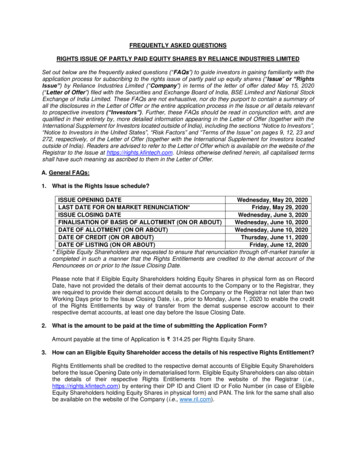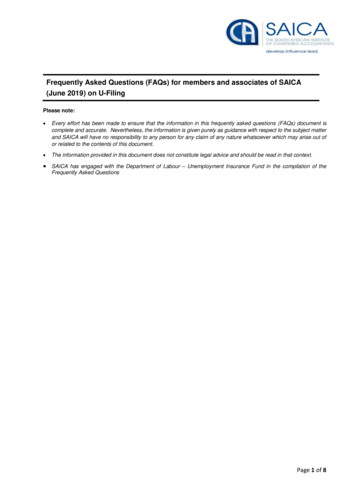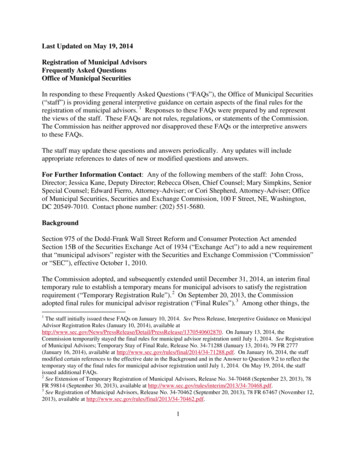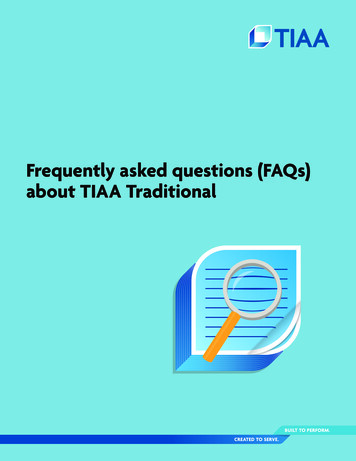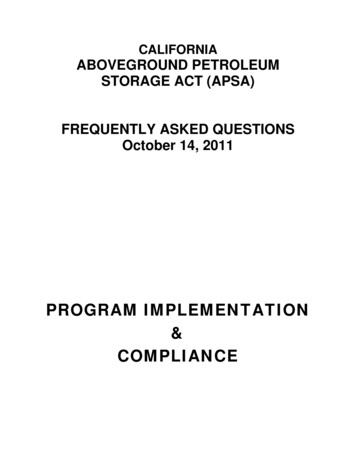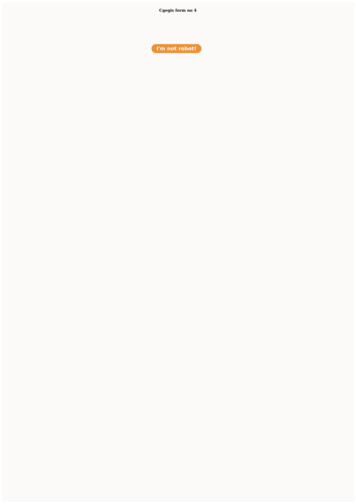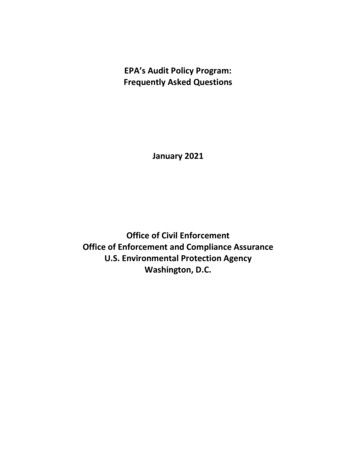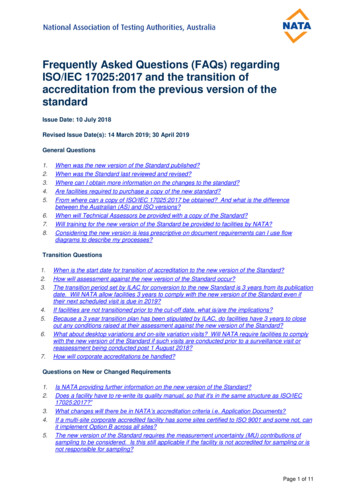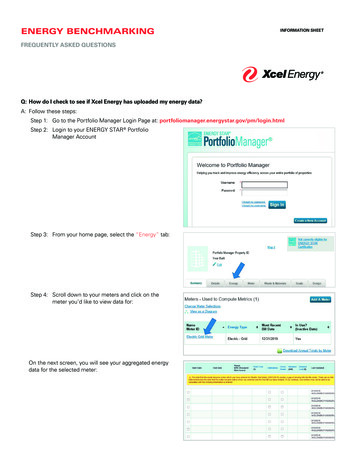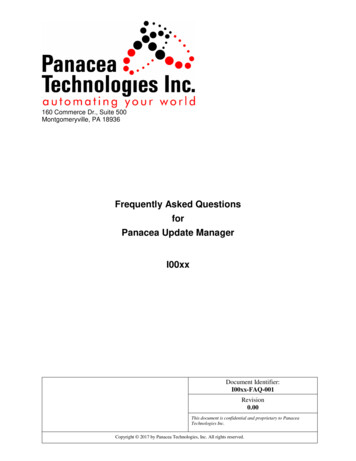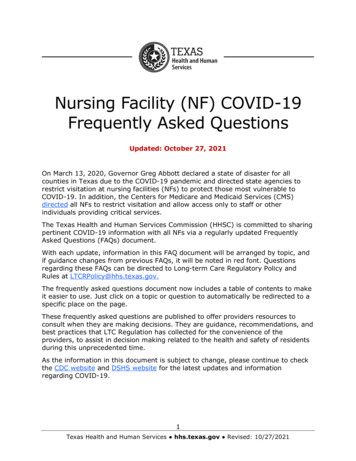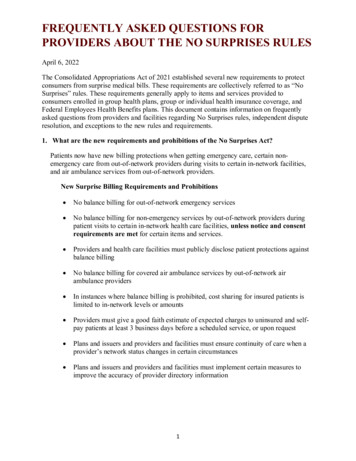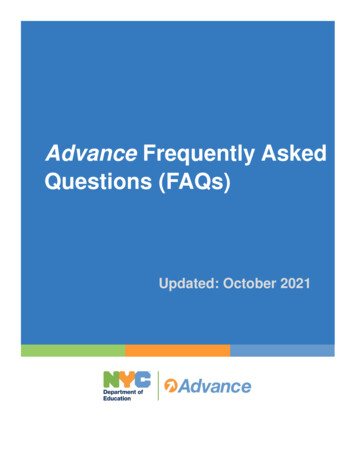
Transcription
Advance Frequently AskedQuestions (FAQs)Updated: October 2021
OVERVIEWThis document supplements the information provided in the resourcesbelow and provides answers to specific questions and situations thatmay arise. Please use the resources below to find general informationon each content area.Resources:Advance InfoHubThe Advance InfoHub holds all information and resourcesregarding the Advance teacher development and evaluationsystemAdvance Web ApplicationAccess the Advance Web ApplicationGeneralInitial Planning Conference (IPC) ToolkitTeacher Improvement Plan (TIP) ToolkitMid-Year Conference ToolkitSummative EOY Conference ToolkitMeasures of Teacher Practice (MOTP)MOTP InfoHubMeasures of Student Learning (MOSL)MOSL InfoHubMOSL Selections GuideOverall RatingsOverall Ratings Guide2
Table of ContentsOVERVIEW2Resources: 2FREQUENTLY ASKED QUESTIONS (FAQs)1. TEACHER ELIGIBILITYError! Bookmark not defined.41.1 General 41.2 Specific Situations82. MEASURES OF TEACHER PRACTICE (MOTP)2.1 Evaluators112.2 Conferences132.3 Classroom ObservationsOverview of Key Terms: 1611163. MEASURES OF STUDENT LEARNING303.1 General 303.2 Assessments and Target Populations323.3 Growth Measurement: Growth Models and Goal-Setting3.4 Specific Situations: Teachers374. TEACHERS’ ADVANCE OVERALL RATINGS 424.1 Advance Overall Ratings425. DATA SYSTEMS THAT SUPPORT ADVANCE5.1 Advance Web Application4343337
1. TEACHER ELIGIBILITY1.1 General1.1.1 Which teachers are evaluated using the Advanceteacher development and evaluation system?K-12 classroom teachers 1 who teach 40% or more of a full-timeposition are eligible to be evaluated using the Advance system. Afull-time teaching position usually corresponds to five teachingperiods per day. 2The charts below show specific categories of employees that areand are not eligible under New York State Education Law 3012-d.This list is not comprehensive; it addresses some of the mostfrequently asked questions about categories of teachers. Teachersnot evaluated using Advance are evaluated using theSatisfactory/Unsatisfactory (S/U) system.3Teachers who are eligible forevaluation using AdvancesystemCareer and technical teachersInstructional Employees whowill be evaluated using S/UsystemPre-kindergarten teachersAdult, community, and continuingeducation teachers (includingGED teachers)Attendance teachers, counselors,secretaries, dental hygieneGeneral education teachersSpecial education teachers,ESL teachers, SETSS1Full-time K-12 classroom teachers who maintain active status for at least six (6) cumulativecalendar months during the current school year are evaluated using the Advance system.2For example, in these schedules, teachers must teach at least two periods per day or theequivalent of two full days per week to be eligible under Advance; in a typical secondary school,where teachers teach 25 periods a week, a teacher who teaches fewer than 10 periods perweek is not eligible for Advance.3Questions about S/U evaluation should be directed to HR Connect at 718-935-4000.4
Teachers who are eligible forevaluation using Advancesystemteachers, AIS teachers, andresource room teachersTransfer school, andD79 non-GED teachersLibrariansInstructional Employees whowill be evaluated using S/Usystemteachers, psychologists, socialworkersNon-public school teachersTeachers who teach less than40% of a full-time position(including coaches/deans)4Long-term substitutes whoteach 40% or more of a full-timeposition 5YABC teachersHome and hospital teachersSpeech teachers who performonly related services 6ROTC teachers 7IEP teachers 81.1.2 Are teachers from the Absent Teacher Reserve (ATR)eligible for Advance?ATRs who meet the eligibility requirements listed in FAQ 1.1.1 areeligible for Advance and must be evaluated accordingly. Schoolleaders are advised to mark these teachers eligible and meet all4Only Librarians who are considered a teacher of record and who are assigned groups ofstudents for instruction for 40% or more of a full-time position are eligible under Advance. Forthe 2019-20 school year, librarians who spend more than 60% of their time teaching flexibleschedules are not eligible under Advance.5Per Diem teachers are not eligible for Advance.6We estimate that the large majority of speech teachers in NYC only provide related services atthis time. Please contact your Teacher Development and Evaluation Coach (TDEC) if youbelieve you have a speech teacher who does not only provide related services.7ROTC teachers who spend 100% of their time teaching ROTC are not eligible under Advance.If a teacher spends part of his/her time teaching classes other than ROTC, then the aboveeligibility rules apply.8IEP teachers who teach 40% or more of a full-time position are eligible to be evaluated usingthe Advance system.5
Advance requirements for any teacher whose eligibility is still inquestion.1.1.3 Who is eligible to receive a Teacher Improvement Plan(TIP) under Advance, and what does the TIP include?Any teacher who received an Advance Overall Rating of Ineffectiveor Developing for school year 2020-21, and is teaching in anAdvance-eligible position in 2021-22, will receive a TIP in 2021-22.Teachers who are not eligible for Advance in 2021-22 will notreceive a Teacher Improvement Plan (TIP), but may receiveindividualized professional development in order to supportcontinuous improvement.Teachers have the opportunity to collaborate with their evaluatorin TIP development and will be supported in TIP implementation.TIPs include a maximum of three specific areas in need ofimprovement related to the teacher’s Ineffective or t(s)/subcomponent. The teacher determines one area ofimprovement. The evaluator shall determine up to two areas ofimprovement. If a teacher chooses not to select an area ofimprovement, the evaluator may determine the third area ofimprovement.Once finalized, a copy of the TIP should be shared with theteacher and placed in the teacher’s file. For more informationon TIPs, see the TIP Toolkit, which includes protocol informationand best practices.6
1.1.4 Teacher license: Does a teacher’s license area impacthis/her MOTP or MOSL?No. Measures of Teacher Practice and Student Learning shouldbe based on the grades/subjects that a teacher teaches, not on ateacher’s license area.1.1.5 Does a teacher’s work setting (in school building, fullyremote, or blended learning) impact teachereligibility?All of a teacher’s teaching time, regardless of work setting, countstoward their total teaching time for purposes of determiningeligibility. If applicable, if a teacher’s work setting changes (i.e.,from in person to remote learning, from remote learning toblended learning, or from remote to in-person), they remaineligible under Advance.Teachers can be observed for evaluative purposes both in schoolclassrooms and remote classrooms if the teacher meets theeligibility requirements under Advance.For 2021-22, observations for evaluative purposes may only beconducted within remote classrooms within 24 hours prior notice.Observations for evaluative purposes cannot be conducted withina remote classroom on the first day of an emergency closure.1.1.6 Teacher trainings and resources: What is the AdvanceAnnual Training Session?Training will be provided to all eligible employees regarding theimplementation of the Advance observation cycle (including therole of the Danielson Framework for Teaching) and MOSL. This7
training shall be provided to all eligible teachers at each worksiteduring the workday no later than the last Friday in October(October 29 in 2021). In addition, teachers can access links toAdvance tools and resources on the Advance Annual TrainingInfoHub page.1.2 Specific Situations1.2.1 How does Advance work for itinerant teachers? Howare Measures of Student Learning selected, and whodoes their Measures of Teacher Practice observationsand conferences?An itinerant teacher (i.e., a teacher who teaches at multiplelocations concurrently) must be marked as eligible in the AdvanceWeb Application by the school(s) in which the teacher teaches, ifthey meet eligibility requirements to be evaluated under Advance.The payroll school is responsible for conducting itinerant teachers’Initial Planning Conferences and Summative End-of-YearConferences. Observations should be conducted at any of theteacher’s locations in which the teacher teaches. The principal ofan itinerant teacher’s payroll school should work with supervisorsat the non-payroll school(s) where the teacher teaches to ensurethat required observations are completed. Hard copies of thesesigned Teacher Observation Reports should be sent to the payrollschool for inclusion in the teacher’s permanent file by the end ofthe school year.Itinerant teachers’ Measures of Student Learning (MOSL)selections are determined by the NYCDOE across allgrade/subjects the teacher teaches, based on application of the8
50% rule. This means that all grade/subjects are aggregated by theNYCDOE, and then the 50% rule will be applied to the selectionsto determine the set of grade/subjects that will be used in theteacher’s MOSL. For itinerant teachers’ MOSL selections, noschool – neither the payroll nor the non-payroll school – shouldmake or confirm teacher-level MOSL selections.9
1.2.2 Are teachers who do not serve the full year eligiblefor Advance (e.g., those who are hired late in the yearor go on leave unexpectedly)? Will they be eligible ifthey switch schools?Teachers are evaluated under Advance if they serve at least sixcumulative months during the school year, regardless of whetherthey serve in one school or multiple schools.Teachers who are ineligible for Advance will receive an S/U rating.School leaders are advised to meet Advance requirements for anyteacher whose eligibility is still in question.All teachers serving students should be observed and providedwith meaningful feedback.1.2.3 How does Advance work for District 75 inclusionprogram teachers? How are Measures of StudentLearning selected, and who does their Measures ofTeacher Practice observations and conferences?A D75 inclusion teacher must be marked as eligible in the AdvanceWeb Application by the school(s) in which the teacher teaches, ifthey meet eligibility requirements to be evaluated under Advance.This service mandates a full day instructional program for the D75inclusion teacher (also known as a D75 Inclusion Program or D75SETSS program teacher) and therefore meets eligibilityrequirements to be evaluated under Advance.Community schools should confirm the teacher as eligible (ifapplicable, as per FAQ 1.1.1), ensure they are scheduled inSTARS, and review and confirm their teacher-level MOSLselections in the AWA. Inclusion teachers will not appear in10
community school MOTP data reports and will not impactobservation completion data in the Advance Web Application.District 75 schools should confirm the teacher as eligible (ifapplicable, as per FAQ 1.1.1), conduct the Initial PlanningConference, observations, and Summative End-of-YearConference. They should also ensure that the Shared Instructionguidelines have been followed, which include adding the teacherto Shared Instruction on ATS.2. MEASURES OF TEACHER PRACTICE (MOTP)For general information regarding MOTP, please review theAdvance MOTP InfoHub.2.1 Evaluators2.1.1 How are evaluators trained to use the DanielsonFramework for Teaching fairly and accurately?To ensure that the City’s APPR plan is implemented fairly andaccurately, the New York State Education Department (NYSED)requires that evaluators receive robust training. All evaluatorsreceive ongoing job-embedded implementation support fromTeacher Development and Evaluation Coaches (TDECs). Thissupport focuses on helping school leaders support teachers withunderstanding the rubric and developing their practice, and alsoguides school leaders through the process of teacher evaluation.In addition, principals must complete recertification trainingannually in order to serve as lead evaluators. For a returningprincipal to achieve re-certification for the 2021-22 school year,s/he must meet the following criteria:11
1) SY 2021-22: Participate in Job-Embedded Support (5hours). Job-embedded support includes two visits with aTDEC, focused on inter-rater reliability and support toimplement Advance while engaging teachers in theprocess.2) Fall-Winter 2021: Participate in a video review ofteaching practice facilitated by a TDEC.Principals who have not completed initial certification as leadevaluators (for example, new principals) must complete therequirements above and also meet the following criteria:3) SY 2021-22: Participate in Additional Job-EmbeddedSupport (2.5 hours). This additional visit with a TDEC willfocus on an introduction to Advance policy and focus oninter-rater reliability and support to implement Advance.2.1.2 In addition to the principal, who else can serve as anevaluator?Assistant principals and other school-based supervisors andadministrators can serve as secondary evaluators under Advance.Secondary evaluators can perform many of the same Advancerelated tasks that lead evaluators perform, for example:A. Hold Initial Planning and Summative End-of-YearConferences;B. Discuss, prepare, and monitor progress of TeacherImprovement Plans;C. Conduct informal and formal classroom observations; andD. Give feedback and ratings based on lesson-specificevidence.12
Please note that principals, as lead evaluators, are responsible fordetermining a teacher’s annual Advance rating and signing off onTeacher Improvement Plans.2.2 Conferences2.2.1 Which meetings must be scheduled by mutualagreement? Initial Planning ConferencePre-Observation Conference, Formal Observation,and Post-Observation ConferencePlease note that the Summative End-of-Year Conference is notrequired to be scheduled at a mutually agreed-upon time.2.2.2 What is the window during which Initial PlanningConferences can be held?Initial Planning Conferences (IPCs) may be held between the firstday teachers report to school (September 9 in 2021) and the lastFriday in October (October 29 in 2021). For teachers who areabsent from the first day of school until the last Friday in October(including those who commence service after the last Friday inOctober), the IPC should be conducted within 10 school days ofhis or her return to school.2.2.3 What are the expectations for the Initial PlanningConference?The IPC is a mandatory, one-on-one meeting between the teacherand evaluator that occurs prior to any formal or informal evaluativeclassroom observation. The purpose of the IPC is for the teacher13
and evaluator to discuss the teacher’s continuous growth anddevelopment for the school year, reflecting upon previousevaluations, if any, the teacher’s area of focus, and the school’sinstructional priorities. Teachers may choose to set professionalgoals as part of the IPC, however it cannot be required of them.Additionally, teachers may choose to indicate a preference for howthey wish to receive feedback from observations during this time.Assistant principals and other secondary evaluators may conductthe IPC. This meeting must be scheduled at a mutually agreedupon time between the teacher and evaluator. There is nominimum length of time for an IPC (i.e., it does not need to be a fullclass period), but the conference must be long enough to cover allof the requirements. At this meeting, teachers are required toindicate whether observations can be recorded via video.Teachers make their choices by completing and signing the IPCForm. For teachers who know they will receive a formalobservation as part of their assigned observation option, the IPCmay serve as a teacher’s pre-observation conference if the teacherchooses and if the IPC occurs between 1 and 20 school days priorto the formal observation.Teachers rated Ineffective or Developing based on criteria set forthin FAQ 1.1.3 will also discuss their Teacher Improvement Plan(TIP) during the IPC. For these teachers only, the IPC must beconducted by October 8 for 2021-22.2.2.4 When do Summative End-of-Year Conferences occur?When should the Summative End-of-Year Conferenceoccur if the teacher is absent at the end of the year?Summative End-of-Year Conferences between a teacher andevaluator(s) may occur anytime between the last Friday in April14
and the last Friday in June when school is in session. For schoolyear 2021-22, Summative End-of-Year Conferences may takeplace between April 29, 2022 and June 24, 2022. Note that, unlikeIPCs, evaluators are not required to hold Summative End-of-YearConferences at a mutually agreed upon time but are encouragedto accommodate teacher schedules whenever possible. More thanone evaluator may be present at the evaluator’s discretion.When a teacher is absent between the last Friday of April and thelast Friday in June, and the absence is foreseen and the evaluatorwas aware the teacher would not be present during this period(e.g., teacher is taking maternity leave), the Summative End-ofYear Conference shall be held before the teacher leaves. If theabsence was unforeseen (e.g., extended leave) and therefore theevaluator could not conduct the Summative End-of-YearConference, it must be held no later than the last Friday in Octoberof the following school year (October 28 in 2022 for school year2021-22); if this occurs evaluators have discretion to conduct boththe IPC and Summative End-of-Year Conference at the same time,so long as requirements for both meetings are fulfilled.2.2.5 What are expectations for a Summative End-of-YearConference?Advance-eligible teachers participate in a face-to-face SummativeEnd-of-Year Conference with their principal and/or other evaluator.The purpose of this collaborative conversation is to reviewfeedback and ratings from observations of practice and to identifyareas of improvement and next steps toward the teacher’scontinued professional growth; the Danielson 2013 Framework forTeaching serves as the common language for a discussion ofareas of improvement that were observed throughout the schoolyear and what next steps should be taken for future growth.15
Evaluators may schedule conferences before all of a teacher’sobservations are complete, and must have copies of all completedTeacher Observation Reports available for review at theconference; note that all evidence to inform teacher ratings mustbe captured on the Teacher Observation Report.There is no required documentation to submit for the SummativeEnd-of-Year Conference. If the teacher set optional goals at thestart of the school year, the results of those goals may also bediscussed for professional development purposes.2.3 Classroom ObservationsOverview of Key Terms:Observation Cycle: includes three distinct steps: observation,feedback (delivered in a manner determined by the evaluator), andissuance of the final Teacher Observation Report.Teacher Observation Report: This report is completed by theevaluator within 30 school days of a teacher’s evaluativeobservation for Advance. It requires evaluators to provide lessonspecific evidence gathered during an observation for allcomponents rated. This form also has a space for additionalevaluator notes and/or feedback, which are optional. It can beprepared by entering teachers’ ratings in the Advance WebApplication or off-line by printing a blank Teacher ObservationReport (in PDF or Microsoft Word) from the Advance InfoHub. Thecompleted Teacher Observation Report shall be provided to theteacher no later than thirty school days.Sample completed Teacher Observation Reports of ratings basedon informal and formal observations are available on the AdvanceMOTP InfoHub. Note that these samples provide an illustration for16
training purposes and are not intended to illustrate every possibleuse of the form.Evidence: Specific, observable features of teaching practicecaptured by evaluators taken during any formal or informalclassroom observation; it may also include direct observations ofpractice related to components 1a, 1e, and/or 4e captured within15 school days preceding an observation unless it was used aspart of a letter to file. Any notes are the sole property of theevaluator and do not constitute a record of the teacher observationprocess and, therefore, will not be included within a teacher’s file.Evidence is drawn from the observation process, including notesrecorded on the Teacher Observation Report.Feedback: Evidence-based commentary that is aligned to theDanielson Framework for Teaching provided to the teacher within10 school days following an observation. Feedback should includethe sharing of evidence and shall also include notification to theteacher regarding whether or not the observation will be used forevaluative purposes. The primary purpose of feedback is to helpteachers improve; for example, a school leader may note observedareas of strength and growth for the teacher and also note one ortwo specific actions that the teacher can take to improve his/herpractice. Feedback shall be through an in-person conversation, inwriting, via e-mail, or through any other form of communication andmust be shared prior to the issuance of the final TeacherObservation Report. Feedback shall include notification to theteacher regarding whether or not the observation will be used forevaluative purposes. Teachers may choose to indicate apreference for how they wish to receive feedback fromobservations during their Initial Planning Conference.17
Initial Planning Conference: a mandatory one-on-one meetingbetween the teacher and evaluator that is held at a mutually agreedupon time and occurs prior to any formal or informal classroomobservations required by Advance. During the IPC, the evaluatorand teacher meet face-to-face to discuss expectations for the yearahead.Pre-observation conference: individual, face-to-face meeting aspart of each formal observation held within 20 school dayspreceding the scheduled date of the formal observation. Thepurpose of the Pre-Observation Conference is to review theobjectives, activities, and expectations for the lesson that will occurduring the teacher’s formal observation.Post-observation conference: individual, face-to-face meeting,held at a mutually agreed upon time within 20 school days followingthe formal observation. The Post-Observation Conferenceprovides the teacher and evaluator the opportunity to discuss theobservation and engage in a meaningful conversation about theteacher’s practice and discuss next steps for development.Principals may choose to share feedback prior to the postobservation conference.Summative End-of-Year Conference: a mandatory face-to-faceindividual meeting between the Advance-eligible teacher andhis/her principal and/or other evaluator. The purpose of thiscollaborative conversation is to review feedback and ratings fromobservations of practice and to identify successes, areas forgrowth, and next steps toward the teacher’s continued professionalgrowth. It is also an opportunity to reflect on available student datathat may inform ways to improve teaching practice so studentslearn and grow.18
2.3.1 What are the components of the observation cycle inAdvance?The Advance observation cycle includes three distinct steps:observation, feedback (delivered in a manner determined by theevaluator), and issuance of the final Teacher Observation Report.Feedback shall include notification to the teacher regardingwhether or not the observation will be used for evaluativepurposes. Feedback must be shared prior to the issuance of thefinal Teacher Observation Report. The Teacher ObservationReport shall be provided to the teacher no later than thirty schooldays of the observation; it must be completed, signed by theevaluator and teacher, to be placed in the teacher’s file.Additionally, from the time an observation is conducted until thetime the teacher receives the Teacher Observation Report for thatobservation, only one additional evaluative observation may beconducted.2.3.2 How many observations are used for evaluativepurposes each year?Recognizing that teachers are at different stages of their careersand who have achieved different levels of proficiency, as indicatedby the Framework for Teaching, observations differ in the numberand type of classroom observations that the teacher receives overthe course of the year. There is no maximum number ofobservations a teacher may receive. After an observation,feedback shall include notification to the teacher regarding whetheror not the observation will be used for evaluative purposes.The DOE will use a teacher’s most recent probationary status (nolater than the last day of the Initial Planning Conference window)19
when assigning the MOTP observation option. If a teacher is onleave or not yet active until after the last day of the Initial PlanningConference window, then the status they have when they becomeactive will determine their MOTP observation option.Probationary StatusFinal APPR rating inthe previous yearCompleted Probation(on or before October29, 2021)“Highly Effective” or“Effective”“Developing”“Ineffective” or“Unsatisfactory”No rating or a ratingother than any listedabove20Number of observations thatare used for evaluativepurposes in SY2019 - 2020Minimum two (2) informalobservationsMinimum of one (1) formal andthree (3) informal observationsMinimum of one (1) formal andfour (4) informal observationsMinimum of one (1) formal andthree (3) informal observations
ProbationaryStatusFinal APPR rating in theprevious yearProbationary“Highly Effective,” “Effective,”“Developing,” “Satisfactory,” orno rating“Ineffective” or “Unsatisfactory”Number of observations thatare used for evaluativepurposes in – SY2021-22Minimum of one (1) formal andthree (3) informal observationsMinimum of one (1) formal andfour (4) informal observationsOption PROSE: Teachers in PROSE schools that have voted toinclude Option PROSE may select this option for MOTP. Teachers cannot be required to select into Option PROSE.Teachers who would like to select Option PROSE for the2021-22 school year may make that selection during theInitial Planning Conference (IPC). The teacher’sadministrator will then change the option in the AWA andcan print the IPC Form with Option PROSE selected. For teachers who select Option PROSE there will be:o Minimum of two (2) informal classroomobservations lasting a minimum of 15 minutes each(both may be unannounced but one must beunannounced); ando A Structured Review that includes a specific area offocus, a mid-year check-in conference, and a finalreview.For more information, please review the Implementing OptionPROSE Guidance.2.3.3 When can evaluators begin observations and howoften can they conduct observations?Evaluators can begin classroom observations for evaluativepurposes for a teacher immediately following the IPC. Additionally,evaluators can always visit classrooms as part of general school21
supervision, as well as for formative or developmental purposesthroughout the year. There is no limit to the number of evaluativeobservations (formal or informal) that can be conducted.2.3.4 When do observations occur? What are the evaluationwindows?In order to ensure that teachers receive responsive feedback atappropriate intervals throughout the year, the school year shallconsist of two evaluation windows. The Fall Window forobservations begins with the Initial Planning Conference and endson the last day of the Fall term. The Spring Window forobservations begins the first day of the Spring term and ends withthe first Friday in June. Half of the required minimum number ofobservations shall be done in the Fall Window. Half of the requiredminimum number of observations shall be done in the SpringWindow. In situations where the minimum number of observationsis three or five, the additional observation may occur in eitherwindow.The Teacher Observation Report may be provided outside of thewindow for observations that are conducted within the window(e.g., after an observation conducted on January 15, theobservation report may be provided on February 5). However, norequired observation shall begin in the Spring Window until the finalTeacher Observation Report for all required observations from theFall Window have been provided to the teacher. Nothing preventsevaluators from conducting more than the minimum number ofobservations.22
Note that all timelines must be adhered to absent extraordinarycircumstances (e.g., certain types of leaves); teacher absences donot count against these timelines.2.3.5 How many observers may be present duringobservations?During both formal and informal evaluative observations, no morethan one evaluator and two school-based observers (i.e., thesuperintendent, assistant superintendent, or trained administratorof the teacher’s school) may be present. The evaluator is solelyresponsible for completing the Teacher Observation Report.2.3.6 What are the feedback requirements forobservations?To help ensure that teachers are provided with timely feedback ontheir practice, evaluators are required to provide lesson-specificfeedback to teachers within 10 school days of any evaluativeobservation. Feedback shall include notification to the teacherregarding whether or not the observation will be used for evaluativepurposes. Feedback shall be through an in-person conversation,in writing, via e-mail, or through any other form of communication.Every effort should be made to provide feedback within 10 school23
days to the teacher; however, if a teacher is absent, the 10 day“clock” stops until they return.2.3.7 What is the difference between (p&p) and (obs) on theTeacher Observation Report?In the Advance Web Application, there are two places to enterevidence and ratings on the Teacher Observation Report forcomponents 1a, 1e, and 4e — preparation & professionalism(p&p) and observation (obs).In the observation (Obs) f
system teachers, AIS teachers, and resource room teachers teachers, psychologists, social workers Transfer school, and D79 non-GED teachers Non-public school teachers Librarians 4. Teachers who teach less than 40% of a full-time position (including coaches/deans) Long-term substitutes who
